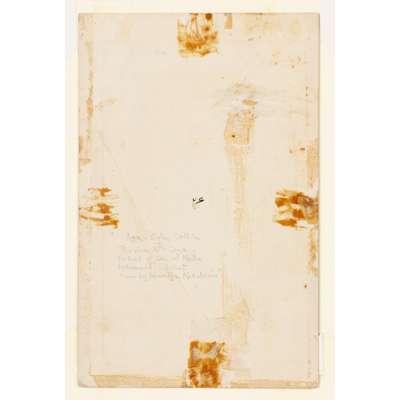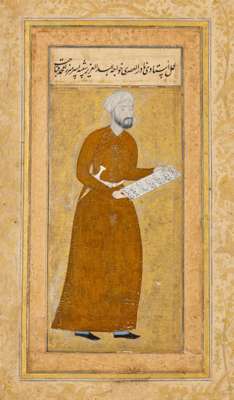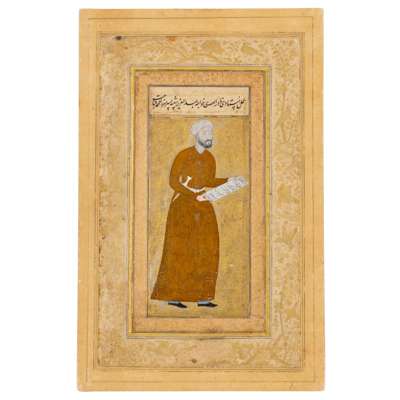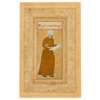
Lot 37

A PORTRAIT OF MIRZA-MUHAMMAD, SON OF KHWAJA QABAHAT, BY ABD AL-AZIZ ‡
PERSIA, TABRIZ, CIRCA 1540-45








Auction: 10 December 2025 from 14:00 GMT
Description
ink, gouache and gold on paper, mounted with borders of gold-decorated pink and cream paper within dark blue and gold margin lines, depicting Mirza-Muhammad wearing a brown robe, holding an inscribed document, a dagger tucked into his white belt, wearing a white turban, above the image a line of nasta'liq in black ink, verso with a handwritten note in English in pencil referring to the Aga-Oglu collection and raqqam numbers in black ink, the back board with a handwritten note by S.C. Welch, a Fogg Museum exhibition label and other labels
Dimensions
23.4cm x 15cm
Provenance
Possibly, the collection of Philip and Frances Hofer, in circa 1947 (judging from a handwritten note).
Formerly, the Aga-Oglu Collection (1896-1949).
Formerly, the Stuart Cary Welch Collection (1928-2008).
Sotheby’s, The Stuart Cary Welch Collection, Part One: Arts of the Islamic World, 6 April 2011, lot 79.
The collection of a German enthusiast.
Footnote
Exhibited:
Wonders of the Age, The British Library, London; The National Gallery of Art, Washington D.C., the Fogg Art Museum. Harvard University, 1979-1980.
Literature:
S. C. Welch, Wonder of the Age, Cambridge, 1979, pp. 188-89
M. Dickson and S. C. Welch, The Houghton Shahanameh, Cambridge, 1981, Vol.I, p.227.
Inscriptions:
Inscribed in thulth on the sheet of paper held by the subject, partially repeated in the nasta‘liq inscription above:
‘aya malik al-mulk ‘amal-i ustadi nadir al-‘asri khwaja ‘abd al-‘aziz shabih-i pisar mirza muhammad qabahat’
‘O Possessor of Dominion! The masterful work the wonder of the age, Khwaja ‘Abd al-‘Aziz. Likeness of the boy Mirza Muhammad [son of] Qabahat’
This wonderful painting is, in every way, exceptional. It was previously in the collections of two of the greatest historians of Islamic art of the 20th century. It was also painted by one of the most influential and important painters at the court of Shah Tahmasp, ‘Abd al-‘Aziz, who was himself involved in the painting’s bizarre and dramatic backstory.
The subject of this painting is identified by the inscription on the document he is holding; it identifies him as one of the protagonists in an extraordinary event that also involved the artist responsible for the painting, Khwaja ‘Abd al-‘Aziz, as well as another court painter of Shah Tahmasp, ‘Ali Asghar. According to the Ottoman biographer of artists and calligraphers, Mustafa ‘Ali, the painter Khwaja ‘Abd al-‘Aziz was infatuated with the Shah’s favourite page boy, a certain Mirza Muhammad son of Khwaja Qabahat. He tricked the youth into fleeing with him and the painter ‘Ali Asghar to Shiraz, from where they intended to go to the port of Hormuz and sail to India. They presented the governor of Shiraz with a forged letter from the Shah to the effect that provisions should be made for them for the journey. The Shah’s men caught up with them however and they were brought before the Shah who contemplated putting them to death. On considering Khwaja ‘Abd al-‘Aziz’s outstanding talent, however, the Shah reduced their punishment, however, cutting off the Khwaja’s nose and ‘Ali Asghar’s two ears with his own hands. Mirza Muhammad’s was punished with a short spell in prison (Kıvanç 2011, pp. 268-70; Dickson and Welch 1981, vol. 1, p. 227).
A reduced version of this story is given by the biographer Qazi Ahmad who simply states that Khwaja ‘Abd al-‘Aziz had fallen in with bad company and was punished for forging the Shah’s seal by having both his nose and his ears cut off. Qazi Ahmad also supplies that information that he was the son of another celebrated painter, ‘Abd al-Wahhab, and that both son and father were natives of Kashan. He confirms the information that he was an intimate of the Shah as well as his tutor in painting (Minorsky, p. 186). Qazi Ahmad also separately mentions Mirza Muhammad the son of Khwaja Qabahat as a talented calligrapher as well as, according to a rival, a catamite (ibid148-149). Perhaps the fine inscription on the piece of paper Mirza Muhammad is holding here was written by himself?
Though according to ‘Ali’s testimony, Khwaja ‘Abd al-‘Aziz was a ‘Bihzad-like’ master who was particularly prized by the Shah and even tutored him in painting (ibid., p. 268), according to D. Duda, only a single painting, excluding the present one, can be firmly attributed to him, a depiction of an enthroned ruler in a palace surrounded by his court, now in the Bibliothèque nationale de France (BnF Suppl. Pers. 1572, f. 2v), which may in fact be a portrait of the shah himself (Duda 1982).
The back of this painting carries notes in Stuart Carey Welch’s own handwriting, one of which records a coincidence surrounding the picture’s arrival with him: "This fascinating picture was delivered .... entirely unexpectedly, at the moment when Martin Dickson was telling me about the misadventure of Abd al-Aziz, Mirza Muhammad and Shah Tahmasp - an astonishing, God-given coincidence.""Admire not only the portrait but the contemporary border, probably also by Abd al-Aziz".
BIBLIOGRAPHY
Esra Akın-Kıvanç (ed., trans.), Mustafa ‘Ali’s Epic Deeds of Artists, Leiden and Boston, 2011
Martin Bernard Dickson & Stuart Cary Welch, The Houghton Shahnameh, 2 vols, Cambridge, Mass. & London, 1981
D. Duda, “Abd-Al-Aziz B. Abd-Al-Vahhab”, Encyclopædia Iranica, I/1, 1982, pp. 97-99, online version (last accessed 31 October 2025) at https://www.iranicaonline.org/articles/abd-al-aziz-b-abd-al-vahhab/
Vladimir Minorsky (trans.), Calligraphers and Painters: A Treatise by Qadi Ahmad, Son of Mir-Munshi, Washington D.C., 1959
Stuart Cary Welch, Wonders of the age: masterpieces of early Safavid painting, 1501-1576, Cambridge, Mass., 1979.







